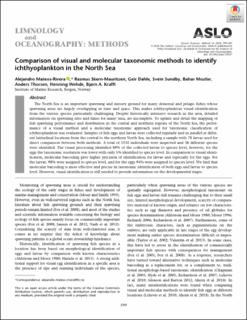| dc.description.abstract | The North Sea is an important spawning and nursery ground for many demersal and pelagic fishes whose spawning areas are largely overlapping in time and space. This makes ichthyoplankton visual identification from the various species particularly challenging. Despite historically intensive research in the area, detailed information on spawning sites and times for many taxa, are incomplete. To update and detail the mapping of fish spawning performance and distribution in the central and northern regions of the North Sea, the performance of a visual method and a molecular taxonomic approach used for taxonomic classification of ichthyoplankton was evaluated. Samples of fish eggs and larvae were collected regularly and in parallel at different latitudinal locations from the central to the northern North Sea, including a sample with 78 larvae used for direct comparison between both methods. A total of 5332 individuals were inspected and 36 different species were identified. The visual processing identified 89% of the collected larvae to species level, however, for the eggs the taxonomic resolution was lower with only 5% identified to species level. In comparison to visual identification, molecular barcoding gave higher precision of identification for larvae and especially for the eggs. For the larvae, 98% were assigned to species level, and for the eggs 94% were assigned to species level. We find that molecular barcoding is more effective and precise in taxonomic identification of both eggs and larvae to species level. However, visual identification is still needed to provide information on the developmental stages. | en_US |
